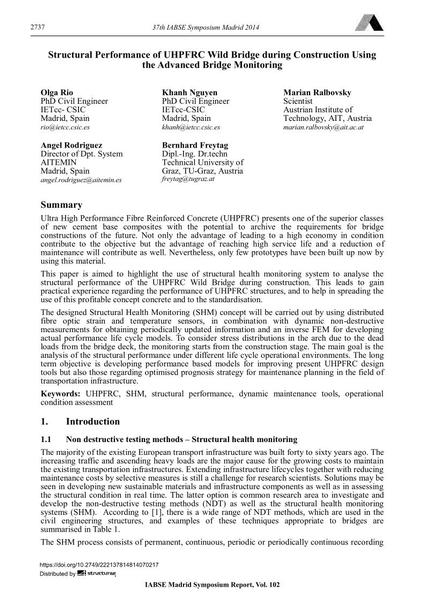Structural Performance of UHPFRC Wild Bridge during Construction Using the Advanced Bridge Monitoring

|
|
|||||||||||
Détails bibliographiques
| Auteur(s): |
Olga Río
Khanh Nguyen Marian Ralbovsky Ángel Rodriguez Bernhard Freytag |
||||
|---|---|---|---|---|---|
| Médium: | papier de conférence | ||||
| Langue(s): | anglais | ||||
| Conférence: | IABSE Symposium: Engineering for Progress, Nature and People, Madrid, Spain, 3-5 September 2014 | ||||
| Publié dans: | IABSE Symposium Madrid 2014 | ||||
|
|||||
| Page(s): | 2737-2743 | ||||
| Nombre total de pages (du PDF): | 7 | ||||
| Année: | 2014 | ||||
| DOI: | 10.2749/222137814814070217 | ||||
| Abstrait: |
Ultra High Performance Fibre Reinforced Concrete (UHPFRC) presents one of the superior classes of new cement base composites with the potential to archive the requirements for bridge constructions of the future. Not only the advantage of leading to a high economy in condition contribute to the objective but the advantage of reaching high service life and a reduction of maintenance will contribute as well. Nevertheless, only few prototypes have been built up now by using this material. This paper is aimed to highlight the use of structural health monitoring system to analyse the structural performance of the UHPFRC Wild Bridge during construction. This leads to gain practical experience regarding the performance of UHPFRC structures, and to help in spreading the use of this profitable concept concrete and to the standardisation. The designed Structural Health Monitoring (SHM) concept will be carried out by using distributed fibre optic strain and temperature sensors, in combination with dynamic non-destructive measurements for obtaining periodically updated information and an inverse FEM for developing actual performance life cycle models. To consider stress distributions in the arch due to the dead loads from the bridge deck, the monitoring starts from the construction stage. The main goal is the analysis of the structural performance under different life cycle operational environments. The long term objective is developing performance based models for improving present UHPFRC design tools but also those regarding optimised prognosis strategy for maintenance planning in the field of transportation infrastructure. |
||||
